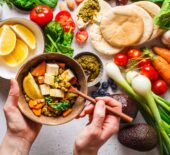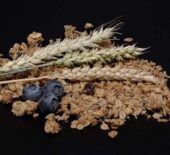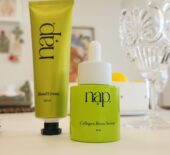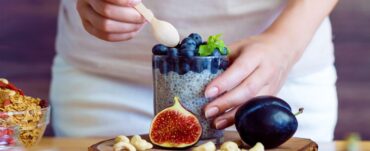If you are like me working out is a pleasure but it’s also great to see the results of my efforts from the gym. Including enough protein is vital to build and maintain muscles. You may think you need to live off stake to keep your muscle but stepping away from a heavy meat diet may benefit not only your health but the environment.
You are not alone if you think following a plant-based diet will restrict your protein and not meet your needs. Good news is protein is a common macronutrient present in almost all the foods you eat except fruit. Even better news is if you follow a balanced plate model, with ½ of your plate vegetable or fruit ¼ protein source and ¼ wholegrain you can easily achieve this. So, what can make up the ¼ of your plate of protein in a plant-based source?
Tofu or soybeans, also chia seeds and hemp seeds are great choices as these foods all contain all the nine essential amino acids or building blocks of protein your body needs to make up a protein in your body.
There are many other varieties of plant sources of protein you can enjoy. Most of these plant proteins have an incomplete amino acids profile. This means they do not have all the essential amino acids your body needs to make a protein. This is why variety in your plant proteins are important this includes legumes, wholegrains, nuts and seeds. When several different plant proteins are enjoyed in your meals and snacks, they can fill in the missing amino acids to help your body make a complete protein.
I personally chose to use Healthyroo as a protein range which is made using pea and rice proteins. Together this combination provides my body with a complete protein source. Per serve it gives 19.8-20.2g of protein in the Zest Slim range. 10-20g of protein per snack and 20-40g of protein per meal is a goal amount to provide your body with enough protein throughout the day to build and maintain your muscle mass. On top of this Healthyroo’s products include other vitamins and minerals which are essential for healthy function as well as to promote recovery from my workout.
Ways which I like to include more plant-based eating in my week include:
- For breakfast a superfood detox acai bowl https://healthyroo.com.au/blogs/news/superfood-detox-acai-bowl
- Mexican: ½ cup of red kidney beans with 1/4 cup of brown rice and the rest of your dish a cup or more of your favourite vegetable mix such as tomatoes, sweet potato etc. Flavour with herbs and spices.
- Trail Mix: 30g of air popped corn, 15g seeds 15g nuts and 1.5 tablespoons of sultanas
- Yogurt Combo: 200g of low or no fat yogurt with 1.5 tablespoons of oats and ½ cup of berries. (Note yogurt is an animal based food and as such contains all your essential amino acids.)
- An easy Lunch: 2-3 Wholegrain rice cakes with 1-2 tablespoons of hummus and 1 cup of salad vegetables (if you need an extra protein kick try adding a boiled egg which also contains all your essential amino acids)
- Pasta: ½ cup of whole grain pasta/quinoa/couscous with 1 cup of chickpeas and 1 cup of mixed cooked vegetables including tomato paste. Flavour with herbs and spices.
- Indian: 1 cup of brown rice with 1 cup of lentils and 1 cup of cooked vegetables cooked in extra virgin olive oil (7-14g per person = 1.5-3 teaspoons). Flavour with curry powder and chilli as desired.
- A delicious Healthyroo banana smoothie https://healthyroo.com.au/blogs/news/banana-smoothie
Take home message: I chose to follow a plant-based style of eating as it helps to add more variety, fun and flavour to my diet as well as save me a dollar or two over a meat-based alternative.
References
1.Messina M. Insights gained from 20 years of soy research. J Nutr. 2010 [cited 2018 Jan 08]; 140:2289S-95S. Abstract available from: https://www.ncbi.nlm.nih.gov/pubmed/20980639
2.Messina M. Soybean isoflavone exposure does not have feminizing effects on men: a critical examination of the clinical evidence. Fertil Steril. 2010 [cited 2018 Jan 08];93(7):2095-104. Abstract available from: https://www.ncbi.nlm.nih.gov/pubmed/20378106
3.Beaton LK, McVeigh BL, Dillingham BL, Lampe JW, Duncan AM. Soy protein isolates of varying isoflavone content do not adversely affect semen quality in healthy young men. Fertil Steril. 2010 [cited 2018 Jan 08];94(5):1717-22. Abstract available from: https://www.ncbi.nlm.nih.gov/pubmed/19819436
4.National Toxicology Program (NTP) Center for Evaluation of Risks to Human Reproduction (CERHR). Final Center for Evaluation of Risks to Human Reproduction Expert Panel Report on soy infant formula. National Institute of Environmental Health Sciences, National Institute of Health; 2010 [cited 2018 Jan 08]. Available from: https://ntp.niehs.nih.gov/ntp/ohat/genistein-soy/soyformula/soymonograph2010_508.pdf
5.Balk E, Chung M, Chew P, Ip S, Raman G, Kupelnick B, et al. Effects of soy on health outcomes. Evid Rep Technol Assess. 2005 Aug [cited 2018 Jan 08]; (126):1-8. Citation available from: https://www.ncbi.nlm.nih.gov/pubmed/16194125.
6.Chavarro JE, Toth TL, Sadio SM, Hauser R. Soy food and isoflavone intake in relation to semen quality parameters among men from an infertility clinic. Human Reproduction. 2008 [cited 2018 Jan 08];23(11):2584-590. Abstract available from: https://www.ncbi.nlm.nih.gov/pubmed/18650557








